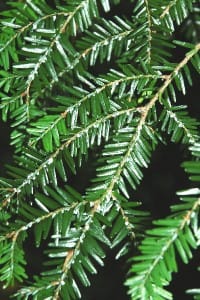Source(s): Charles Seabrook
From the mountains to the sea, Georgia’s forests are facing environment calamities that could forever change our natural landscape. Two insects, the Hemlock wooly adelgid and the Asian ambrosia beetle are two recently introduced species to Georgia that have killed thousands of trees statewide.
Hemlock Wooly Adelgid
In north Georgia’s mountains, a tiny exotic insect known as the hemlock wooly adelgid is destroying magnificent Eastern hemlock trees in record numbers. Tens of thousands of hemlocks already have been lost in Rabun, Habersham, White, Towns and Union counties, and the threat is spreading south and west, according to the Georgia Forestry Commission. If the pest is not controlled, scientists predict that Georgia and neighboring states could lose 90 percent of their hemlocks within the next decade.
In essence, Georgia could be faced with losing the hemlock as a forest species – an ecological catastrophe that would equal the loss of the American chestnut tree during the last century. The long-lived, shade tolerant hemlock provides food and shelter for many species – including the redbreasted nuthatch and Blackburnian, Swainson’s and black-throated green warblers.
Georgia’s hemlocks often grow to stately heights along streams, where their deep shade helps keep water temperatures cool enough for trout . The roots and canopy help prevent soil erosion. Hemlock stands are also preferred habitats of rare amphibians, including the green salamander and hellbender.
The hemlock wooly adelgid, a native of Asia was first identified in the United States in the early 1950s near Richmond, where it entered through a plant collector. As an introduced species, it came without the natural enemies that keep it in check in its native setting. The adelgid has moved steadily into the southern Appalachian forests. In 2002, it was discovered in Georgia in Rabun County.
The adelgid lays its wooly egg sacs, about the size of a match head, on the undersides of hemlock branches. In spring, the larvae hatch and the tiny adelgids begin sucking the sap from the base of the needle. This deprives the hemlock tree of water and nutrients. After several years of infestation, the tree dies.
Right now, the best hope for combating the hemlock wooly adelgid is releasing into the forest exotic beetle species that naturally prey on the pest. A laboratory is set to open soon at the University of Georgia to raise the beetles.
No one, however, is sure if the effort will save the hemlocks. Also, introducing an exotic species is risky business. But given the crucial importance of the hemlock and the distinct possibility that we could lose these trees, scientists need to use every resource available to fight the spread of the hemlock wooly adelgid.
Asian Ambrosia Beetles
Getting less attention is the widespread loss of native red bay trees in the coastal forests due to a fungus spread by the exotic Asian Ambrosia beetle. Reds bays in the Okefenokee Swamp have been hard hit by the fungus according to the Georgia Forestry Commission. Numerous dead red bay trees in a Liberty County maritime forest and on Ossabaw Island have also been noted by the Georgia Forestry Commission.
The red bay is a medium-sized evergreen tree whose showy fruits are eaten by songbirds, wild turkey and quail. Its spicy, aromatic leaves have been used for flavorings in soups and meat dishes. “The outlook is dismal for our red bays,” according to the James Johnson, forest health coordinator for the Georgia Forestry Commission. “And we are very concerned about the sassafras. The question is , what other tree species will this fungus attack.”
Sassafras trees trees also appear vulnerable. The sassafras, one of Georgia’s most common trees, is know for its root beer-like fragrance. In the 1500s, French traders shipped large quantities of sassafras from Georgia back to Europe, where it was used in a popular herbal tonic.
The tiny ambrosia beetle is native to South Asia. First found in Georgia in 2002, it is believed to have reached the United Staes in packing crates. The fungus that this beetle carries attacks a tree’s trunk or stems and stops nutrient and water flow, thus killing the tree.
Resource(s):
Reviewer(s):
Randy Drinkard, Technical Writer, UGA Center for Urban Agriculture, The University of Georgia.
Center Publication Number: 208
- Feeding Birds in Winter - September 24, 2013
- Trees Under Insect Attack - September 23, 2013

I live in Dunwoody, GA on the Chattahoochee and have several hemlock trees. I noticed today something that appears to be or is similar to the wooly adeldig on one of them. Is is possible to have a sample tested to determine what it is? If so, how and where?
Yes. You’ll want to contact the folks at your local County Extension Office. In Dekalb county you can find their info on the County Extension website.